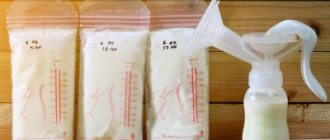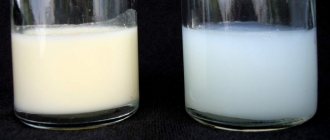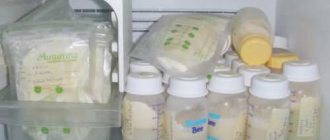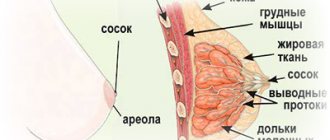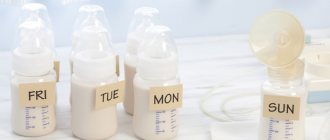Several decades ago, every mother was assured that it was necessary to express milk before and after feeding. There was even a myth according to which the milk remaining in the breast begins to sour. These myths are a thing of the distant past, and experts agree that pumping is not necessary when breastfeeding. There are several indications for which experts advise resorting to this procedure. Just a nursing mother should be aware of how to properly express breast milk.
Why express breast milk?
Cases where experts recommend expressing milk include:
• Strong milk flow
. Usually, 2-3 days after childbirth, many people experience a rush of milk, due to which the breasts become hard and painful. To maintain lactation, you should express breast milk until the mother feels relief. In the first days of life, the baby does not yet have time to suck out a sufficient amount of milk, which leads to its accumulation. Pumping before feeding helps relax swollen breasts and makes it easier for your baby.
• Inability to breastfeed a child
. This usually applies to new mothers who have just had a caesarean section. In order not to lose nutritious colostrum - a special secretion of the mammary glands, which is formed in the first days after childbirth and is an intermediate form during the transition from intrauterine nutrition of the baby to feeding with milk - it is better to express it and then give it to the child.
• Mother's illness
. For some diseases, the doctor may prescribe medications that are incompatible with breastfeeding. To maintain lactation, it is better to express milk during treatment. After recovery, you can return to full breastfeeding.
• Painful sensations
. Women who have established the lactation process often encounter such a problem as lactostasis. This is a condition that is accompanied by blockage of the milk ducts. Because of this, a lump forms in the chest, which causes pain and often provokes an increase in temperature. By expressing milk, you can speed up the flow of fluid and get rid of blockages.
• Inability to breastfeed regularly
. Working and studying mothers simply do not physically have time to breastfeed their child, but want to maintain lactation. The best solution in this situation is regular pumping.
When and how often should you pump?
The timing and number of pumping sessions is one of the most discussed topics among new mothers. There is no clear answer to this question. Some experts recommend doing this before feeding, others after. To understand how often to express breast milk, a nursing mother should focus only on her own situation.
• Situation No. 1. The child was born weak, he developed physiological jaundice, he constantly looks sleepy, and is reluctant to breastfeed. In this case, to maintain lactation, you need to start massaging your breasts 3-4 hours after birth. Subsequently, if the baby suckles for no longer than 10 minutes, you can express the colostrum drop by drop for another 10 minutes.
• Situation No. 2. The baby was born prematurely and is fed through a tube. At this time, colostrum contains the components necessary for the baby. Therefore, even one drop of it is precious. To speed up the development of the child, a young mother can express breast milk, which will be used to supplement her feeding.
• Situation No. 3. The baby and mother are active, there is a lot of milk, but the breast is painful. To alleviate her condition, a nursing mother can express herself once a day. If necessary, the procedure can be increased up to 2-3 times, but no more.
• Situation No. 4. Lactation started well, but gradually faded, and the baby stopped gaining weight. In this case, it makes sense to increase the number of pumping sessions to 5-6 per day. During feeding, you need to ensure that the baby completely grasps the areola.
• Situation No. 5. The mother is separated from the child or is undergoing treatment with drugs incompatible with breastfeeding. To maintain lactation, you need to express 7-8 times a day. At the same time, it is important to select nipples for bottles that imitate the shape of the mother's nipple, and sucking occurs in a natural rhythm, as close as possible to breastfeeding. This way, the baby will not get used to the nipple and after the separation from his mother is over, he will easily return to breastfeeding.
Is pumping necessary?
Previously, expressing milk was considered a prerequisite for maintaining lactation, and this made sense - mothers fed their babies according to a schedule, and this caused a cessation of milk production. It was possible to maintain lactation only with additional regular pumping.
Today, WHO and AKEV experts answer the question of whether it is necessary to express an unequivocal answer - no! This procedure is used only in extreme cases when there is a direct threat to the health of mother and baby.
Dr. Komarovsky believes that a healthy mother with normal lactation does not need pumping. However, he emphasizes that today there are few women with normal hormonal levels, whose body will normally react to the remains of milk in the breast after feeding. It often happens that in response to this, the body “curtails” lactation, believing that there is too much milk.
AKEV specialists are confident that this situation can be corrected by natural feeding without additional pumping. If you make a little effort and offer your baby the breast more often, lactation will improve in a few days and reach the required level of lactation. In any case, if there are no health risks, the mother herself decides whether to express or not, based on the advice of the pediatrician and her own goals.
Do I need to express milk after each feeding?
Based on the opinion of the World Health Organization and AKEV consultants, we can say that women do not need to pump after each feeding unless there is an extremely serious reason for this.
Waiting after feedings can provoke the development of hyperlactation and, as a result, constant congestion or even mastitis. The child simply will not cope with such a volume of milk - he does not need it.
If the mother’s milk supply is low and the baby is malnourished (this is noticeable by weight gain), you should first of all try to strengthen lactation by putting the baby to the breast more often. Nature has provided for all situations, and within a few days the body will adapt to the child’s needs. According to WHO, breastfeeding after breastfeeding to enhance lactation can only be used as a last resort.
Should I pump my breasts before breastfeeding?
In the past, it was often recommended to “pump” the breasts before breastfeeding in order to develop them. Modern breastfeeding consultants are of the opinion that there is no need to express the breast before feeding - if the mother and baby are healthy, they were not separated after childbirth, and the mother does not take harmful medications. A healthy baby is quite capable of independently stimulating the mother’s milk production.
When should you really express milk?
There are several situations when expressing milk is necessary to maintain the health of the mother or baby:
- during stagnation (lactostasis), if the baby cannot cope on his own;
- during the mother’s illness, if medications harmful to the child are prescribed. At this time, the baby is usually switched to formula, and the mother regularly expresses milk to maintain lactation, imitating the baby’s feeding regimen;
- at the birth of a premature or weakened baby, when he cannot suckle on his own. Feeding expressed milk will be a much better option for the baby than formula;
- When the breast is overfilled with milk (“stone breast”), the nipple may become deformed and flattened, then the baby will not be able to latch on and eat normally. To make the task easier for him, the breast is pumped a little - until the nipple “appears”, then the child can cope on his own;
- to preserve milk supply. If you are planning a long separation from your baby (going to work, a session, traveling on business for the whole day), you can express it into a bottle in advance after and between feedings and freeze it by hour X.
Many mothers are interested in the question of whether it is necessary to express milk when stopping lactation. If breastfeeding ends naturally, breastfeeding occurs gradually, the demand for milk is reduced and the body, accordingly, reduces its production. In this case, there is absolutely no need to express - everything happens very smoothly and without any unpleasant sensations for the mother.
In the case when weaning is carried out abruptly, for example, due to the mother’s illness or other circumstances, the body needs much more time to adapt, and the mother may suffer for some time from the unpleasant consequences of refusal - breast fullness, pain in the breast, or even mild inflammation.
If possible, such a sudden weaning should be smoothed out as much as possible - gradually (once a week or at least every 2-3 days) by removing one of the feedings and replacing it with a mixture or other food.
If this is not possible, you will have to pump. The main thing is not to empty your breasts until they become soft - this will only stimulate the production of prolactin. When you stop breastfeeding, you can express milk only until you feel relieved. If you don't pump at all, stagnation, lactostasis, or even mastitis can form.
After pumping, you can apply a cold compress or a cold cabbage leaf to your breasts. They are good at removing incipient inflammation and relieving the feeling of fullness in the chest.
Expressing when there is stagnation of milk in the breast
Lactostasis is a problem that many nursing mothers face. To get rid of blocked milk ducts, you need to put your baby to the breast more often. If this is not possible, you can resort to pumping. Before this, you can lightly massage your breasts or use the targeted effects of a warm shower. Milk should be expressed little by little, only until the mother’s condition improves. Otherwise, the body will perceive this as a signal for increased lactation. As a result, this will not only not improve, but will also worsen the situation.
Many mothers are interested in how to express breast milk with their hands during congestion. This must be done carefully, moving along the milk ducts in the direction from the base of the breast to the nipple. If necessary, you can express milk using a breast pump.
How to express during congestion
Expressing during lactostasis requires more careful preparation - before the procedure you should take a warm shower and massage your breasts under running water. In a difficult situation, it would not be amiss to add cabbage compresses, add honey to the leaves and hold for 15 minutes. Then empty the breast manually; there is no need to use a mechanical breast pump. But we must not forget that lotions can only be done if the woman does not have a fever. Cabbage leaves are replaced with a towel or heating pad soaked in warm water.
Rules for expressing breast milk by hand
If you rarely bottle feed your newborn baby, you can resort to hand pumping. This technique does not require large financial costs, but instead it requires good skill and a lot of free time. Although supporters of this pumping technique consider this method to be the most environmentally friendly and effective. To do this, you need to follow the following algorithm:
1. Wash your hands thoroughly.
2. Prepare a sterilized container with a wide neck to collect expressed breast milk.
3. Place your palm on your chest so that your thumb is 5 cm from the areola (areola) and rises above the other fingers.
4. Press your hand to your chest.
5. Bring your thumb and index finger together, making sure that they are only on the areola and do not slide onto the nipple.
6. Wait until the first drop of milk appears.
7. Rhythmically repeat the movements of your fingers, moving them in a circle to influence all milk passages.
8. Keep your fingers further away from the nipple to express more milk and prevent painful pressure.
Rules for expressing breast milk using a breast pump
Despite the safety and environmental friendliness of the manual method, if you are short of free time, it is better to resort to expressing with a breast pump. Many mothers are interested in whether it is possible to express breast milk with an electric device. Modern manufacturers offer manual and electric breast pumps, which are made from safe materials, correspond to the anatomical features of the female breast, and are adjustable in speed and power. So the choice between them should be based solely on the mother’s own preferences and budget.
Electric breast pumps are equipped with a special pad that is applied to the breast and encircles it evenly. When turned on, a vacuum is created, due to which milk begins to be released from the breast. In hand-held devices, instead of an electric motor, a special mechanism is installed, which, when pressed, also creates a vacuum. Both devices are equipped with special milk receivers.
In general, it takes about 45 minutes to fully express both breasts. To reduce the pain that arises during the process, you can choose a breast pump model that simulates the effect of sucking.
About the advantages of manual expression
As we have already said, hand expression has a number of advantages, in particular, it is a softer and more natural method that does not require financial expenditure.
In addition, skin-to-skin contact is more effective in stimulating milk production than plastic devices. The natural way of expressing helps strengthen the reflex release of breast milk.
Experts call the manual method the most environmentally friendly way to pump. And some mothers note that when using a breast pump they experience pain and discomfort. Whereas expressing with your hands is painless and comfortable. This is a less traumatic method compared to a breast pump. Removing stagnation of milk in the breast with your hands is easier and safer than using a mechanical device.
Hand expression is available anytime and anywhere: you don’t have to worry about forgetting your breast pump or not being able to, for example, sterilize it.
You can express milk manually under any circumstances, because you always have everything you need with you (not counting the bottle, which, in extreme cases, can be replaced with any available container).
It takes no more than five minutes to express one breast. Then you need to change the breast. In general, the process will take about half an hour, sometimes a little less - everything is individual.
- share with your friends!
Contraindications for expressing breast milk
There is no justifiable reason why you should not express milk. On the contrary, this procedure helps maintain lactation when the mother is sick, cannot often breastfeed the baby, or is tormented by strong flows of milk. However, there are also no clear indications for pumping. If possible, it is better to maintain lactation. By overcoming some difficulties immediately after the baby is born, you can regulate the process of milk production and enjoy breastfeeding for a long time. A properly established lactation process will eliminate the need to look for answers to the question of how to express breast milk.




